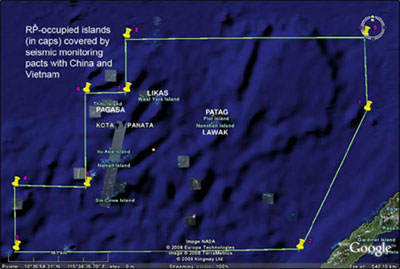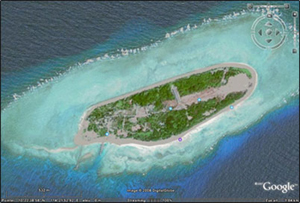MANILA, Philippines - Six islands occupied by the Philippines in the disputed Spratly Islands Groups are covered by two controversial joint seismic monitoring agreements among the Philippines, China and Vietnam that have come under fire for purportedly "sacrificing" Philippine interests in exchange for huge loans from Beijing. Based on coordinates provided in the annex to both agreements, the agreement area includes Patag (Flat), Lawak (Nanshan), Parola (Northeast Cay), Panata (Lankiam Cay), Kota (Loaita) and Likas (West York) islands occupied by the Philippine military.
The agreement also covers 24,000 square kilometres of undisputed Philippine territory. The area’s easternmost edge is around 25 kilometers from the southern tip of Palawan. At its northern boundary, the area abuts the Malampaya oil field and includes an area the Philippines had long awarded to a British company for oil exploration. Of the total 142,886 kilometers, around 24,000 square kilometers clearly belong to the Philippines and fall outside the areas in the Spratlys which are claimed either in whole or in part by the Philippines, China, Vietnam, Taiwan, Indonesia and Brunei. The area also swallows almost 80 percent of the Kalayaan Group which the Philippines claims. The Spratly island itself, which serves as the island group’s main reference point, is at the westernmost area covered by the agreement and about 700 kilometers from Palawan.
Largest island The 142,886-square-kilometer study area also covers Itu Aba, the largest island in the disputed group of islands and the only one claimed and held by Taiwan, a non-signatory to the 2004 agreement. Known as Tai Ping Island to Taipei, Taiwan President Chen Shui-bian inaugurated Feb. 3 a 1,150-meter-long runway on the island, drawing protests from Philippine officials who called the visit "unfortunate" and "lamentable." Taiwan, one of the six claimants to the oil-rich group of islands in the South China Sea, has not officially reacted to the bilateral agreement between Beijing and Manila, and the tripartite agreement the two countries subsequently entered into with Hanoi since these deals recently got into the limelight. The Arroyo administration has come under fire amid allegations it received huge loans extended by China, including the corruption-tainted National Broadband Network project, after cutting the deals.
The deal The Joint Marine Seismic Undertaking signed on Sept. 1, 2004 between Philippine National Oil Co. and China National Offshore in Beijing during the state visit of President Gloria Macapagal Arroyo was expanded six months later to include Petro Vietnam. The Spratlys are being claimed wholly or in part by the Philippines, China, Vietnam, Malaysia and Taiwan and Brunei. The more or less 160 islands are claimed wholly both by China and Taiwan. Vietnam occupies 25 islands; China, nine; the Philippines, eight; Malaysia, three, and Taiwan, one. Brunei has established a fishing zone that overlaps a southern reef. Under the agreements, Sonca (Sand Cay) and Nam Yit Islands, and Collins and Da Nu Thui (Petley) Reefs claimed by Vietnam are covered by the pre-exploration study area. So are the reefs claimed by China: Landsowne (Da Len Dao), Yong Shu Jian (Fiery Cross), Nan Xun Jiao (Gaven), Kennan and Subi. Sinh Cow, the main site of clashes between Chinese and Vietnamese troops in the past, is also in the agreement area.
Regime of cooperation Retired Commodore Rex Robles, who was part of the team that prepared the 1960's handbook on the 53-islets in the South China Sea being claimed by the Philippines, said in an interview that a "militarily weak" Philippines initiated the regime of cooperation among the six claimants to deter Chinese aggression. By entering into the bilateral agreement with China, Robles said, the Philippines "undercut our own initiative to talk to China as a group." He added, "To add to the offense, we allowed China to have access for study purposes to other islands without permission by the other claimants." Robles said the Philippines, by entering into the agreement with China, has likewise taken Beijing's side in its sovereignty dispute with Taiwan. The Philippines maintains a "One-China Policy" and recognizes Beijing as representing the Chinese people. But the Philippines maintains economic and cultural relations with Taiwan, which hosts some 160,000 Filipino workers. The Joint Marine Seismic Undertaking is a three-year agreement for the Philippines, China and Vietnam to undertake a seismic study "to gather and process data on stratigraphy, tectonics and structural fabric of the subsurface of the area." The agreement states that China and the Philippines had held "pre-exploration activity" with "a view of engaging in a joint research of petroleum resource potential of certain areas of the South China Sea."
JDV pushed for 'exploration' Sources at the Department of Foreign Affairs said the original agreement, which was pushed aggressively by then Speaker Jose de Venecia, stipulated "exploration." But then Acting Justice Secretary and now Ombudsperson Merceditas Gutierrez objected, warning that it would be unconstitutional. The Constitution provides that "the exploration, development, and utilization of natural resources shall be under the full control and supervision of the State." Gutierrez dropped her objection when at the last minute, the word "exploration" was deleted and replaced with "seismic study," DFA sources said. Robles said a seismic study is done only when the agencies involved have previously gathered data that pinpointed where they would drill. "That means they are already in the last stage of their undertaking," he said.
Treason? Opposition senators Panfilo Lacson, Antonio Trillanes IV and Maria Ana Consuelo “Jamby" Madrigal have sought an inquiry into the deal, which, they said, is tantamount to treason. Parañaque Rep. Roilo Golez has also called for an investigation at the House of Representatives to make sure that the agreements do not place national interest "in jeopardy." Lacson and other opposition leaders cited reports that the Spratlys deal was tied to the $8 billion projects to be financed with loans from China, including North Rail, South Rail, National Broadband Network and Cyber-Education deals. De Venecia has denied any connection between the agreements and the release of Chinese loans to the Philippines. He reiterated the deals were designed to turn "an area of potential conflict into a zone of peace and development." Foreign Secretary Alberto Romulo, on the other hand, has said the agreements with China and Vietnam are not only consistent with the Philippine Constitution and the 2002 ASEAN-China Declaration on the Conduct of parties on the South China Sea but also "manifest responsible diplomacy to ease tension and promote confidence building in a region where, as noted in the article, the issue of sovereignty of the Spratly islands remains a potential 'flashpoint.'"
VERA Files is the work of senior journalists taking a deeper look at current issues. Vera is the Latin equivalent of "true." 







